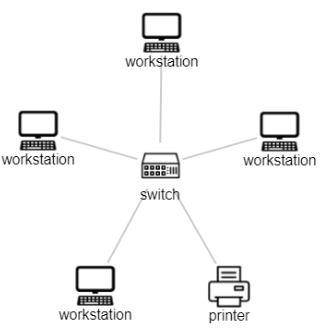Year 9 Exam > Year 9 Notes > Year 9 Computing (Cambridge) > Design Your Own Network: Shape and Size
Design Your Own Network: Shape and Size | Year 9 Computing (Cambridge) PDF Download
Basics of Network Design
What is Network Design?
Network design is the planning of a computer network's infrastructure. It involves determining the layout, hardware, and configuration needed to establish a functional network.

Key Components
- Nodes: Devices such as computers, printers, and servers.
- Links: Connections between nodes, which can be wired (Ethernet cables) or wireless (Wi-Fi).
- Protocols: Rules that govern data transmission, like TCP/IP.
Network Topologies
- Bus Topology: All devices are connected to a single central cable. It's simple and inexpensive but can be slow if many devices are connected.
- Star Topology: Devices are connected to a central hub. It's easy to manage and troubleshoot but can be expensive due to the hub.
- Ring Topology: Devices are connected in a circular fashion. Data travels in one direction, which can reduce collisions, but a break in the ring can disrupt the network.
- Mesh Topology: Devices are interconnected. This offers high reliability and redundancy but is complex and costly.
Types of Networks and Their Configurations
- Local Area Network (LAN):
- Covers a small area like a home, school, or office.
- Offers high-speed connectivity.
- Example: A school network connecting computers in different classrooms.
- Wide Area Network (WAN):
- Covers a large geographic area, like cities or countries.
- Connects multiple LANs.
- Example: The internet or a company's network with offices in different cities.
- Metropolitan Area Network (MAN):
- Spans a city or a large campus.
- Larger than a LAN but smaller than a WAN.
- Example: A city's public Wi-Fi network.
- Personal Area Network (PAN):
- Very small network, often within a single room.
- Connects personal devices like smartphones, laptops, and tablets.
- Example: Bluetooth connection between a phone and a laptop.
- Network Configurations:
- Client-Server Network: Centralized control with dedicated servers providing resources to client computers.
- Peer-to-Peer Network: Decentralized, with each device acting as both a client and a server.
Question for Design Your Own Network: Shape and SizeTry yourself: Which network topology involves connecting devices in a circular fashion where data travels in one direction to reduce collisions?View Solution
Planning and Designing a Network
Steps in Network Design
- Assess Needs:
- Determine the number of users.
- Identify the types of devices to be connected.
- Understand the data traffic and bandwidth requirements.
- Choose Network Topology:
- Select a topology based on the size, scale, and purpose of the network.
- Select Hardware:
- Choose appropriate routers, switches, and cabling.
- Ensure devices support necessary speeds and protocols.
- Design Layout:
- Plan the physical layout of devices and cables.
- Consider future expansion needs.
- Implement Security Measures:
- Set up firewalls, anti-virus software, and encryption.
- Implement access control and user authentication.
- Test and Optimize:
- Test the network for performance issues.
- Optimize configurations for speed and reliability.
Example Scenario: Setting Up a School Network
- Needs Assessment:
- 100 computers across 10 classrooms.
- High-speed internet for online learning.
- Secure access for students and staff.
- Topology Selection:
- Star topology for easy management and troubleshooting.
- Hardware Selection:
- High-speed switches for each classroom.
- A robust router with firewall capabilities.
- Layout Design:
- Central server room for main connections.
- Ethernet cables running to each classroom.
- Security Measures:
- Firewall to protect against external threats.
- User authentication for accessing network resources.
- Testing and Optimization:
- Conduct speed tests in each classroom.
- Adjust settings to minimize latency and maximize speed.
The document Design Your Own Network: Shape and Size | Year 9 Computing (Cambridge) is a part of the Year 9 Course Year 9 Computing (Cambridge).
All you need of Year 9 at this link: Year 9
|
13 videos|5 docs|8 tests
|
FAQs on Design Your Own Network: Shape and Size - Year 9 Computing (Cambridge)
| 1. What are some key considerations when designing a network for UK schools? |  |
Ans. Some key considerations when designing a network for UK schools include ensuring adequate bandwidth for multiple users, implementing robust security measures to protect sensitive data, considering scalability for future growth, and incorporating technology that supports educational objectives.
| 2. How can the shape and size of a network impact its effectiveness in a school setting? |  |
Ans. The shape and size of a network can impact its effectiveness in a school setting by influencing factors such as network performance, connectivity between devices, ease of maintenance, and overall user experience for students and staff.
| 3. What are some common challenges faced when designing a network for UK schools? |  |
Ans. Some common challenges faced when designing a network for UK schools include budget constraints, integrating new technology with existing infrastructure, addressing varying levels of technical expertise among staff, and ensuring compliance with data protection regulations.
| 4. What role does network design play in supporting the educational objectives of UK schools? |  |
Ans. Network design plays a crucial role in supporting the educational objectives of UK schools by facilitating access to online resources, enabling collaboration between students and teachers, and providing a platform for innovative teaching methods that leverage technology.
| 5. How can network design impact the overall learning experience for students in UK schools? |  |
Ans. Network design can impact the overall learning experience for students in UK schools by influencing factors such as access to educational resources, communication with teachers and peers, and the ability to engage in interactive and personalized learning activities.

|
Explore Courses for Year 9 exam
|

|
Signup for Free!
Signup to see your scores go up within 7 days! Learn & Practice with 1000+ FREE Notes, Videos & Tests.
Related Searches
















